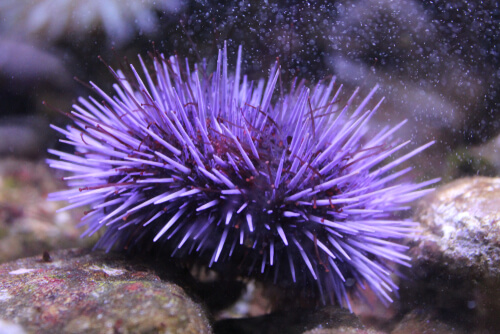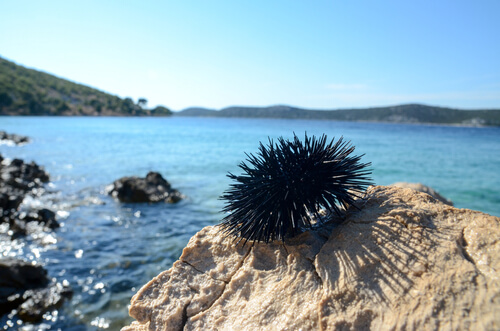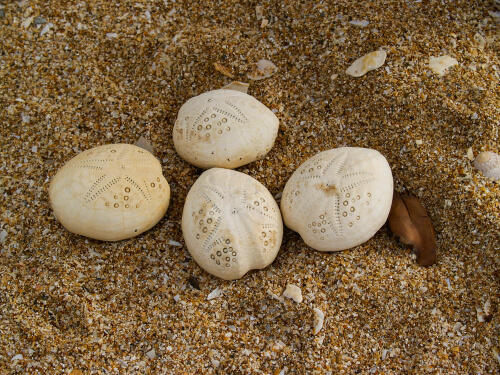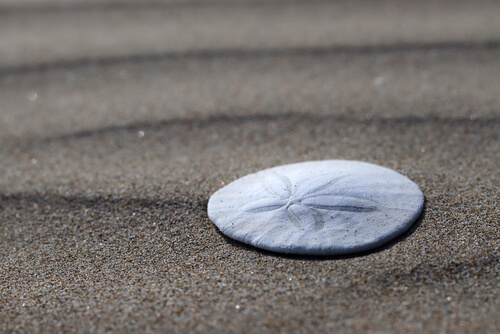
| Kingdom | Animalia |
| Phylum | Echinodermata |
| Class | Echinoidea |
| Order | Cidaroida, Cassiduloida, Spatangoida, Diademotoida, Echinothurioida, Pedinoida, Arbacioida, Echinoida, Physmosomatoida, Salenioida, Temnopleuroida, Clypeasteroida, Holectypoida |
| Niche | Benthic grazers |
| Length | 1-4 in (3-10 cm) |
| Lifespan | 70-100 years |
| Conservation Status | Species dependent |
| Preferred Habitat | Seafloor |
| Average Number of Offspring | Hundred of thousands (broadcast spawners) |
| Main Food Items | Algae, sessile animals |
| Predators | Sea otters, sea stars, eels, fish, humans |
The Basics
The sea urchin refers to a group of about 950 species of spiny, round, marine invertebrates of the class Echinoidea. They can be found on the seafloor throughout the world’s oceans from the intertidal zone all the way to depths of up to 16,000 feet!

Description
Sea urchins consist of a round central shell-like feature known as a test, typically 1-4 inches in diameter. From their tests protrude movable spines of various lengths and colors depending on the species. For example, the pacific purple sea urchin (Stronglyocentrotus purpuratus), a common species found along the west coast of North America, has spines of about one inch while the long-spined sea urchin (Diadema antillarum) is known for its long spines of 4-6 inches in length. In some cases, it can grow spines as long as one foot.
Urchins use a network of thousands of small anatomical features on their undersides known as tube feet to move slowly across the seafloor. They will also use their spines when necessary to help them to overcome obstacles such as rocks or to re-orient themselves after getting tossed around by waves or currents.
Distribution and Habitat
Urchins are often ubiquitous and can be seen throughout the world’s oceans crawling along the seafloor. They are found in tropical, temperate, and polar waters, often in the intertidal zone but many species also live in deeper waters, even into the hadal zone at depths of up to 16,000 feet.

Diet and Predators
Most sea urchins feed on algae that grow on the seafloor. They move along slowly, sweeping it up into their mouths which are located centrally on the underside of their tests. It is this behavior that makes the slate pencil urchin popular in aquariums where they will control algal populations, thus keeping the tank clean.
Some species feed on animals. Of course, not many animals are slower than a sea urchin but they will feed on barnacles, mussels, chitons, limpets, and other sessile species that don’t move quickly and spend most of their lives stuck to the seafloor. They will also feed on already dead and decaying individuals of these and other animal species.
Sea urchins are generally protected by their spines but that does not make them immune from predators. Famously, sea otters feed on the pacific purple sea urchin when available, a trophic interaction that has been demonstrated to maintain the kelp forest ecosystem which these and many other animals inhabit. Other potential predators include eels, starfish, triggerfish, and, of course, humans.
Reproduction
Although difficult to distinguish by appearances, there are distinct male and female urchins. Most urchins have five gonads within their tests, each with a single ‘duct’ rising to an opening in the test known as a ‘gonopore’. When the time is right, urchins will ‘squeeze’ their gametes through this duct and distribute them into the water column where they will mix with the gametes of urchins of the opposite sex and form a fertilized embryo. This type of reproduction is often referred to as ‘broadcast spawning’ as the animals broadcast their gametes into the environment rather than fertilize internally.
Within 12 hours of fertilization by an egg with a sperm, a free-swimming embryo is formed. In most species, this embryo soon forms into a cone-shaped ‘echinopluteus’ larva. These larvae have 12 elongated ‘arms’ that are lined with rows of small cilia which capture foot and sweep it towards their mouths. For months, the larva will float as part of the plankton before the formation of the test plates seen in juveniles. Soon after, metamorphosis occurs while the larva settles onto the seafloor. This small urchin will reach sexual maturity at about two years of age and develop into a full-grown adult within about five years. Sea urchins are generally love-lived, with many species living to be 70-100 years or more. In fact, the red sea urchin (Mesocentrotus franciscanus) may be the longest-lived animal on the planet!
Conservation Status
Populations of most urchin species remain healthy. In fact, in some cases where their predators have been overhunted, sea urchins overrun their kelp forest habitats, effectively eliminating them through overconsumption. As the marine environment continues to change due to a result of climate change, overfishing, and pollution, many of the habitats in which the sea urchin lives are under threat.
Fun Facts about the Urchin!
Urchins are fascinating animals that play a significant ecological role in the ecosystems in which they live. Their unique and complex developmental properties as well as their longevity make them of particular interest to human researchers as well.
A Long Legacy
Like other animals with calcareous hard parts, urchins and other echinoderms have left a long fossil record dating back about 450 million years. This lineage indicated that they are most closely related to sea cucumbers, both of which are deuterostomes – a subphylum of organisms that includes chordates. With our central nervous system organized by our long spinal cords, humans are also a part of the Chordata phylum. These complex connections only further highlight the fascinating evolutionary history of this large phylum of animals.
Not all Prickly

Urchins refers to some 950 species in at least 13 distinct orders. Thus, they are a diverse and varied group of animals. ‘Regular’ echinoids, or ‘sea urchins’, include both “modern” sea urchins (Euechinoidea) and “slate-pencil urchins” (Cidaroidea) which have very thick, blunt spines, often covered with algae and marine sponges. Within the Euechinoidea exists a group of species referred to as ‘irregular’ sea urchins. These include species such as the sand dollar, sea biscuits, and heart urchins, many of which don’t have spines. This adaptation generally allows them to burrow into the sand for protection as an alternative to the protection provided by the long spines of most other urchins.

Fivefold Symmetry
Urchins are echinoderms. Other echinoderms include sea stars, sea cucumbers, brittle stars, and crinoids. A defining feature of echinoderms is their five-fold symmetry, known as pentamerism. Although it is not necessarily easy to see how a spiny echinoderm is symmetric in five distinct planes, it becomes more apparent when their tests are observed. This feature is also most apparent in ‘regular’ sea urchins such as S. purpuratus, whose test is roughly spherical and consists of five equally-sized sections radiating from its central axes.

Bilateral Babies
Despite their adult pentamerism larval urchins demonstrate bilateral symmetry, with symmetry occurring on only one plane much like in humans. This has interesting implications for developmental biology and highlights an important distinction between the regular urchins, which have a mouth on their undersides and an anus on the top, and irregular urchins, which have a distinct front and rear end and thus a certain degree of bilateral symmetry in adults not present in ‘regular’ urchins.
A Testy Organism
The sea urchin is of interest to biomedical researchers for various reasons. First, its embryonic development from a bilaterally symmetric embryo to a fivefold symmetric adult has fascinated researchers for decades. It may have important implications for understanding human and animal developmental biology in general. More recently, however, the phylum has drawn significant interest from evolutionary biologists.
Furthermore, orthologs to human diseases have been discovered. This has led to the investigation of the potential development of therapies through understanding the genome of urchins. Sequences of genes in S. pupuratus, for example, have the power to return cells to a ‘stem-cell like’ state. This would allow for a wide host of improved treatment options for various diseases including Alzheimer’s disease and various forms of cancer. Urchins also have the ability to damage aging tissue, to which they owe their relative longevity. This too has obvious implications for human biomedical research and longevity therapies.
